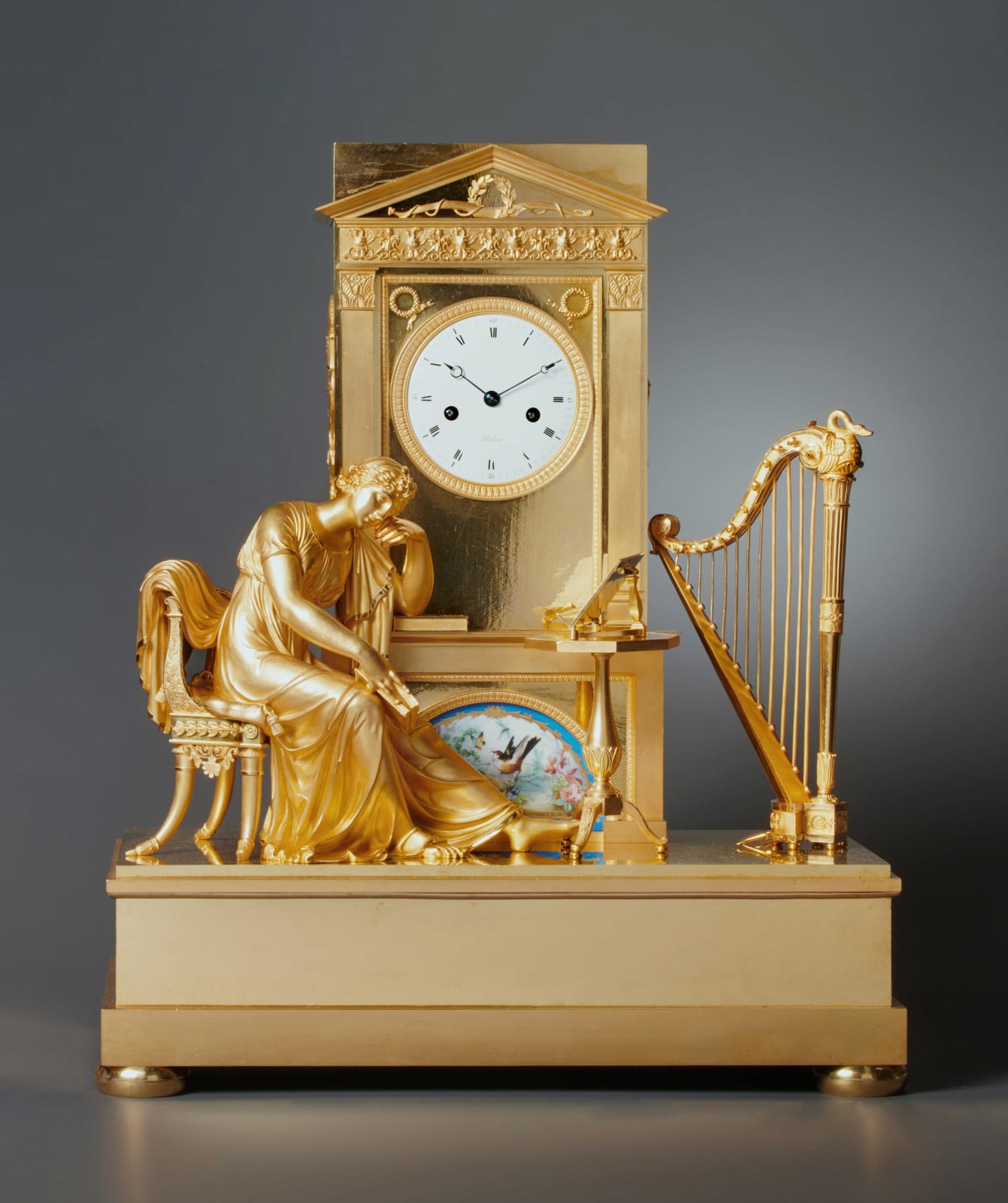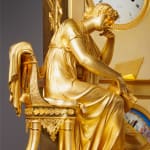Boileau
Further images
Literature
Pierre Kjellberg, “Encyclopédie de la Pendule Française du Moyen Age au XXe Siècle”, 1997, p. 388, pl. A, illustrating a clock of very similar design but without the Paris porcelain plaque and with playful putti mounted on the base.
An extremely fine Empire gilt bronze mantel clock with a Paris porcelain plaque of eight day duration signed on the white enamel dial Boileau. The dial with Roman and Arabic numerals and blued steel moon-style hands for the hours and minutes. The movement with silk thread suspension, anchor escapement, striking on the hour and half hour on a single bell, with outside count wheel. The case with the dial within a stiff leaf bezel set within an upright rectangular plinth with a laurel wreath and bow mounted within an arched pediment above a frieze of swans with outstretched wings, supported at either end on angular pilasters headed by foliate capitals, with ribbon-tied wreaths to the upper dial corners. To the left of the dial plinth sits a young female harpist, dressed in a classical robe and seated on an Empire chair with a scroll back and cornucopia-shaped legs. She rests her elbow on a book and holds in her other hand another book while looking toward her tripod music stand and harp which, headed by a swan, stands to the right of the dial plinth. The lower part of the dial plinth is ornamented with a semi-circular Paris porcelain plaque portraying a bird, butterfly, dragonfly and floral sprays beside water. The whole upon a stepped rectangular base on bun feet
Paris, date circa 1810
Height 52 cm, width 44 cm, depth 22 cm.
The maker responsible for the clock’s movement was the Parisian horloger Sébastien Boileau (1772-1838), who as here signed his name on the dial simply as Boileau or alternatively as Boileau à Paris. Boileau made movements for a number of other equally fine figural Empire clocks, counting among them one known as L’écouteuse in the salon d’Impératrice at Château de Malmaison. That clock case is of comparable architectural composition and shows a woman in classical dress listening with her ear to a door (the door forming the dial plinth). A maker of note, Boileau exhibited his work and was, for instance, commended by the central jury for his finely made clocks and watches shown at the Produits de l’Industrie Française in 1827. Born on 16th September 1772 at Luxeuil-les-Bains (Haute- Saône), Boileau was the son of François Boileau and his wife Anne-Joseph née Daucourt. By 1794 Boileau had settled in Paris where he initially worked as an armurier (gunsmith) but when he married Geneviève-Augustine Caillieux (1779-1834) in May 1805, he was working as a horloger at 30 rue de l’Hirondelle. He continued to be based in the rue de l’Hirondelle near to the Théâtre-Français until late 1811 or early 1812 when he and his wife moved to 69 rue du Bac. Boileau was later based at 18 rue Vaugirard (his address when he exhibited at the French Industrial Exhibition of 1827) and then four years after his wife’s death, he too died in Paris on 16th June 1838. He and Geneviève-Augustine appear to have had only one child - Louis Auguste Boileau (1812-96) who became a pioneering architect and was one of the first to use cast iron in the construction of churches such as at Mattaincourt, Vosges and the church of St-Eugène, Paris.
The clock case belongs to a group of Empire case designs that revolves around the theme of music, counting among them several others illustrated on the same page as this in Pierre Kjellberg’s book (op. cit). With its swan mount, the harp, like the chair on which the young musician sits as well as the tripod music stand, reflects the contemporary Empire fashion. Swans also appear on the dial plinth’s frieze. These gracious birds often appeared within Empire design and as a particular favourite of Napoleon’s first wife Josephine, feature on a number of pieces of furniture specifically made for her.





